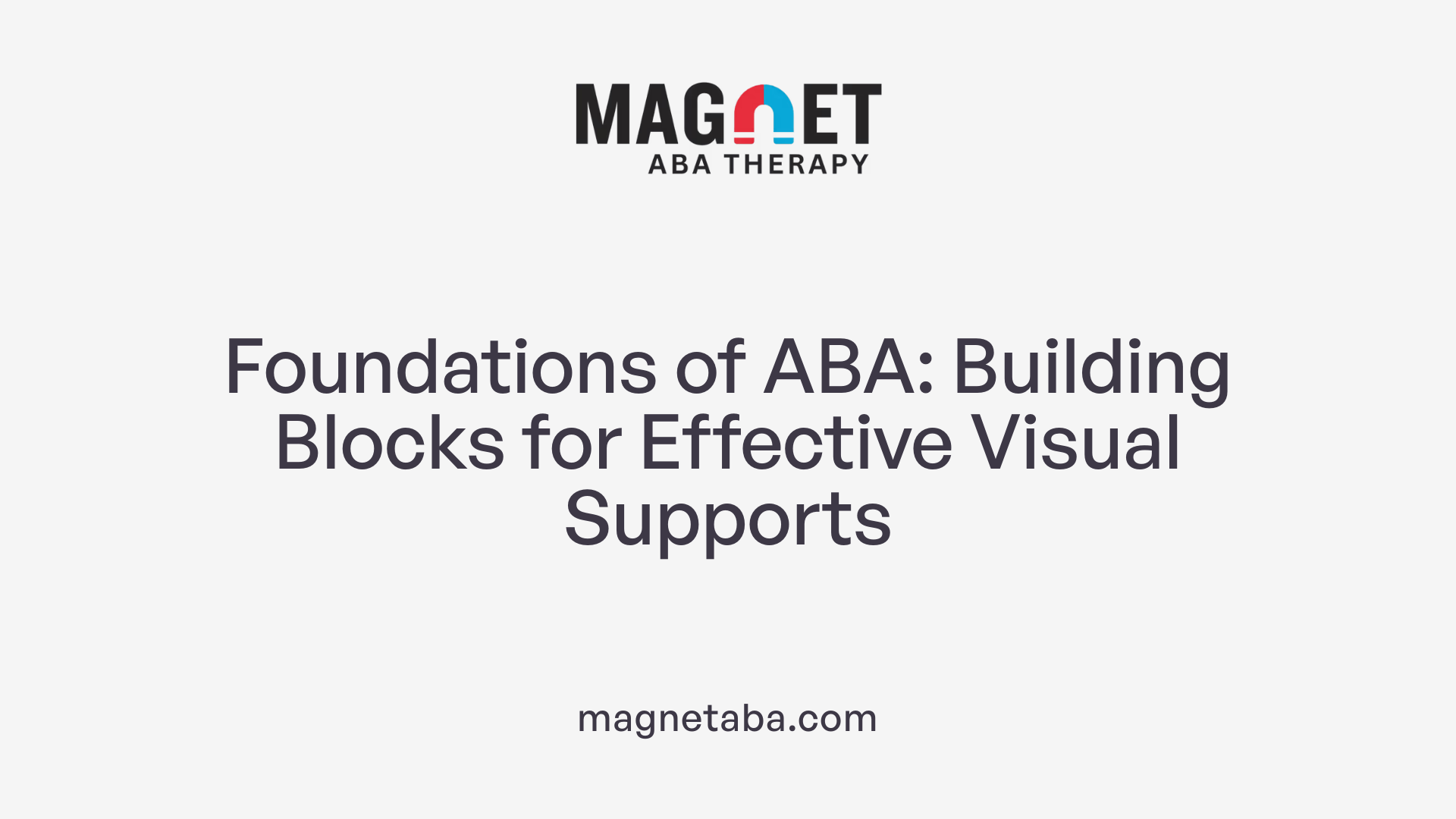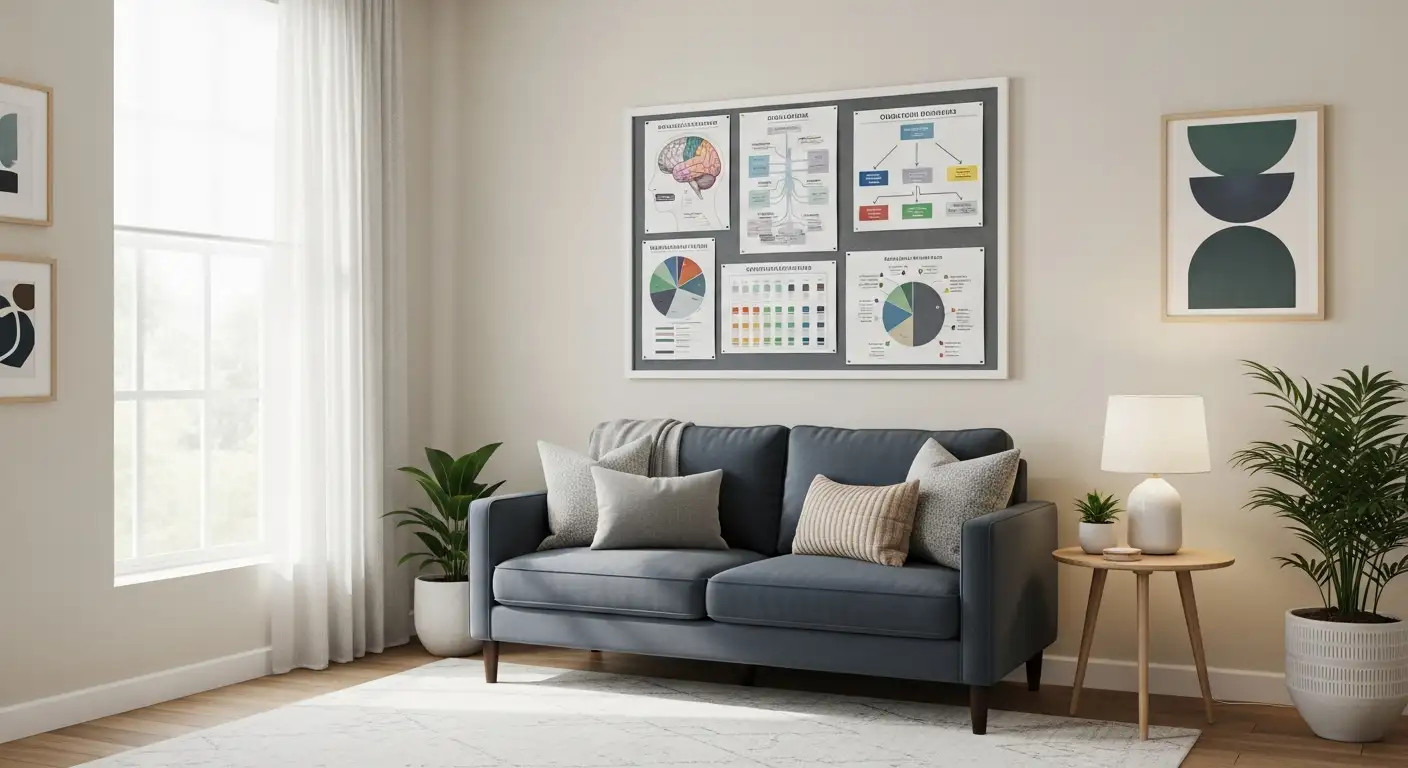Harnessing the Power of Visual Aids in Autism Therapy
Applied Behavior Analysis (ABA) therapy is a proven, science-based approach that enhances the learning and development of individuals with autism through targeted behavior modification techniques. One of the key tools augmenting this therapy are visual supports—personalized visual aids that help children better understand and engage in their therapy and daily life. This article explores how to effectively create these visual supports, their role within ABA therapy, and their impact on children with autism.
Understanding ABA Therapy: The Foundation for Visual Supports

What is Applied Behavior Analysis (ABA) therapy?
Applied Behavior Analysis (ABA) therapy is a science-based approach aimed at improving specific behaviors by applying principles of learning and behavior modification. Its primary goal is to increase helpful behaviors, such as communication and social skills, while reducing harmful or challenging behaviors. ABA involves techniques like positive reinforcement and structured skill training, such as Discrete Trial Training (DTT) and Pivotal Response Treatment (PRT).
Techniques used in ABA therapy
ABA therapy uses a variety of specialized techniques to promote learning and behavior change. These include reinforcement (both positive and negative), visual modeling with charts and videos, prompting and fading to encourage independence, behavior chaining which breaks down complex tasks into smaller steps, behavior contracts outlining rewards and consequences, extinction to reduce unwanted behaviors, and redirection which guides attention away from undesired behaviors. Script fading is also used to assist social interactions and task completion.
Individualization and evidence basis of ABA
ABA therapy is highly individualized, with programs designed to meet each child's unique needs, strengths, and challenges. Board Certified Behavior Analysts (BCBAs) oversee regular adjustments to treatment plans, ensuring the therapy remains effective and relevant. As an evidence-based intervention, ABA has demonstrated significant success in enhancing functioning and quality of life for individuals with autism and other developmental disorders. Visual supports such as schedules, social stories, and cues are often integrated into ABA programs to provide additional structure and clarity, further supporting children’s progress.
How Visual Supports Enhance ABA Therapy for Autism
Role of visual supports in simplifying concepts
Visual supports play a crucial role in helping children with autism understand and navigate their world by breaking down abstract ideas into clear, manageable visual information. These aids, including visual schedules and social stories, transform complex instructions or social situations into understandable formats, making learning more accessible for children who may find verbal explanations challenging.
Creating structure and predictability
One of the primary benefits of visual supports is their ability to create a structured and predictable environment during ABA therapy sessions. Visual schedules outline what activities will occur and in what order, reducing uncertainty. This predictability helps children anticipate changes and transitions, which often eases stress and enhances their engagement.
Reducing anxiety and supporting communication
Visual tools also help lessen anxiety by providing a sense of control and routine. For children who struggle with verbal communication, these supports act as communication bridges that facilitate both understanding and expression. For example, token boards motivate positive behavior through clear visual feedback, while visual cues guide children step-by-step through tasks, fostering greater independence.
ABA therapy benefits individuals with autism by systematically teaching social, communication, and daily living skills tailored to their needs. It employs evidence-based methods such as reinforcement, visual modeling, prompting, and behavior chaining to encourage meaningful behavior change. Incorporating visual supports into ABA programs allows therapists to personalize treatment, making it more effective and comfortable for each child.
Visual supports not only clarify expectations but also empower children to complete tasks with less adult help, thereby promoting autonomy. When combined with ABA techniques, these tools form a comprehensive approach that supports skill acquisition, reduces challenging behaviors, and improves overall quality of life for children with autism.
Types of Visual Supports Used in ABA Therapy

What are visual schedules and how do they function?
Visual schedules are personalized tools that outline the sequence of activities or tasks in a day, helping children with autism anticipate what is coming next. By breaking down the day into clear, visual steps, these schedules simplify abstract concepts into manageable actions, creating a predictable and structured environment.
How are social stories customized?
Social stories are tailored narratives designed to address a child's specific challenges and situations. Therapists create these stories to explain social cues, expected behaviors, or upcoming events in a way that suits each child's comprehension, promoting improved understanding and comfort.
What role do visual cues and prompts play?
Visual cues and prompts serve as targeted guides that assist children during specific tasks, fostering skill development. These supports might include pictures, symbols, or brief instructions that encourage independence and progression in areas like self-care and communication.
How do token boards provide reinforcement?
Token boards act as visual reinforcement tools by tracking the completion of tasks or positive behaviors. Children earn tokens for their achievements, which can later be exchanged for rewards, thereby motivating engagement and encouraging continued positive actions.
By integrating these varied visual supports into therapy, ABA practitioners facilitate clearer communication, reduce anxiety, and build independence in children with autism.
Designing Personalized Visual Schedules and Social Stories
Assessment of Individual Needs
A crucial first step in designing personalized visual schedules and social stories for ABA therapy is conducting a comprehensive assessment of the child's unique strengths, challenges, and learning style. Qualified therapists, such as Board Certified Behavior Analysts (BCBAs), use this information to understand the child's specific communication abilities and social difficulties. This ensures the visual supports are effectively aligned with the child's needs.
Tailoring Stories to Social Challenges
Social stories are custom-crafted narratives that address particular social situations or behaviors the child encounters. By focusing on the child's actual experiences and potential stressors, these stories simplify abstract social concepts and provide clear guidance. This targeted approach helps the child grasp expected behaviors and responses, reducing anxiety and improving social competence.
Collaboration with Families and Therapists
Creating visual schedules and social stories is most effective when therapists work closely with families. This collaboration ensures that the visual supports reflect the child's daily routines and preferences outside therapy sessions. Moreover, involving parents promotes consistency and generalization of skills across home and community settings. Strive ABA Consultants exemplify this approach by integrating family insights with evidence-based strategies for tailored tools.
Implementing a Personalized ABA Therapy Program
Designing visual supports fits within the broader ABA therapy program development process. It begins with assessing individual needs followed by setting specific, achievable goals. Therapists select teaching strategies, including visual modeling, prompting, and behavior chaining, to facilitate skill acquisition. Ongoing data collection guides adjustments, and collaboration among all stakeholders ensures consistency and effectiveness.
By focusing on personalization, visual schedules and social stories become powerful tools that support communication, independence, and comfort for children with autism throughout their ABA therapy journey.
Using Visual Cues, Prompts, and Token Boards to Build Skills
Guiding Task Completion with Visual Cues and Prompts
Visual cues and prompts are essential in ABA therapy for guiding children through specific tasks. These supports provide clear, simple direction that helps break down activities into manageable steps. They are particularly effective in teaching self-care routines, communication skills, and other daily tasks. By offering visual reminders or step-by-step guidance, children can better understand what is expected, which builds confidence and skill mastery over time.
Promoting Independence
One of the significant benefits of using visual prompts and cues is their role in fostering independence. Instead of constantly relying on adult assistance, children learn to recognize and follow these visual indicators on their own. As prompting is gradually faded, the child begins to perform tasks independently. This process not only enhances skill development but also boosts self-esteem as children gain control over their actions and become less dependent on caregivers.
Motivating Positive Behaviors with Token Boards
Token boards serve as a powerful motivational tool in ABA therapy. These boards provide visual reinforcement for completing tasks or exhibiting positive behaviors by allowing children to earn tokens toward a preferred reward. This visual and tangible feedback system encourages consistent effort and helps maintain engagement throughout therapy sessions. By linking positive behavior with immediate, visible rewards, token boards effectively promote desirable behaviors and support behavior change.
Addressing Behavior Modification in ABA Therapy
ABA therapy targets a broad spectrum of behaviors, including communication, social skills, self-care, play, and academic skills. It also focuses on reducing challenging or harmful behaviors by analyzing and modifying environmental factors influencing these behaviors. Through individualized goals and positive reinforcement strategies, ABA supports meaningful behavior change that enhances independence, participation, and overall well-being in children.
Overall, incorporating visual cues, prompts, and token boards in ABA therapy creates a structured and motivating environment. These visual supports guide task completion, encourage independence, and reward positive behaviors, making therapy more effective and engaging for children with autism.
Incorporating Established ABA Techniques with Visual Supports

How does visual modeling support skill acquisition in ABA therapy?
Visual modeling leverages visual aids such as charts, pictures, and videos, combined with verbal prompts, to help children understand and acquire new skills. By providing clear, concrete examples of desired behaviors or tasks, visual modeling simplifies learning and enhances comprehension for children with autism.
What roles do prompting and fading play in promoting independence?
Prompting involves delivering cues to initiate or guide a behavior, while fading gradually reduces these prompts to encourage independent performance. When paired with visual supports like visual cues or schedules, prompting and fading strengthen a child’s ability to perform tasks with less reliance on adult assistance.
How do behavior chaining and script fading improve task completion and social interaction?
Behavior chaining breaks down complex tasks into manageable sequential steps, each supported by visual prompts, making multi-step activities easier to learn. Script fading provides verbal or written guides, often combined with visual aids, to assist children in navigating social situations and completing tasks. Over time, scripts are faded to foster spontaneous and independent interaction.
By integrating these ABA techniques with personalized visual supports, therapists can create tailored programs that promote learning, communication, and independence effectively.
Role of Providers in Creating and Implementing Visual Supports

Professional expertise and training
ABA therapy services are delivered by trained professionals, including Board Certified Behavior Analysts (BCBAs) and registered behavior technicians, who possess expertise in behavior analysis and intervention strategies. These specialists utilize their knowledge to design and implement personalized visual supports, such as visual schedules and social stories, which are tailored to each child's unique needs and learning style. Their professional training ensures that visual tools are applied effectively within evidence-based treatment frameworks to facilitate skill development and behavior change.
Collaboration with families
An essential aspect of creating and implementing visual supports involves close collaboration between providers and families. Providers work alongside parents and caregivers to understand the child's environment, challenges, and strengths, ensuring that visual supports are meaningful and practical beyond therapy sessions. Through this partnership, families are equipped with the knowledge to reinforce the use of visual cues at home, fostering consistency and enhancing the child’s independence.
Importance of personalization and evidence-based practices
Personalization is critical when integrating visual supports in ABA therapy. Providers carefully adapt tools like social stories and token boards to address individual social goals and behavioral objectives. Incorporating evidence-based ABA techniques such as prompting, fading, visual modeling, and behavior chaining alongside visual supports strengthens their effectiveness. Providers ensure that each visual support aligns with scientific principles and measurable outcomes, resulting in more successful and sustainable behavior improvements for children with autism.
Addressing Concerns and Ethical Considerations in ABA and Visual Supports

Are there any criticisms or limitations of ABA therapy?
ABA therapy, while evidence-based and effective for many, faces several criticisms and limitations. Some people find traditional ABA methods to be overly demanding or repetitive, which may increase stress or resistance in certain children. Early forms of ABA occasionally included punitive or aversive techniques that are now considered unethical and largely abandoned. However, concerns about these practices continue to influence public perception.
Critics also worry that ABA might focus too much on conformity, encouraging autistic children to suppress natural behaviors and emotions to fit societal expectations. This approach can sometimes overlook the child's individuality, emotional needs, and personal growth. Another concern is that ABA programs may sometimes emphasize compliance rather than understanding the child's perspective or fostering self-advocacy.
Why is individualized, respectful intervention important?
To address these criticisms, modern ABA therapy stresses the importance of personalized and respectful interventions. Therapists work closely with families and children to tailor visual supports like schedules, social stories, and token boards that reflect each child's strengths, challenges, and preferences. This individualized approach helps promote comfort, independence, and meaningful progress without sacrificing the child's identity.
Respectful ABA emphasizes collaboration with the child and family, ensuring that goals align with the child's needs and values. It balances behavioral objectives with compassion and sensitivity, using visual supports to ease transitions and communications rather than imposing rigid expectations.
How can behavioral goals balance with neurodiversity perspectives?
Balancing ABA's behavioral goals with neurodiversity perspectives means recognizing and honoring the unique ways autistic individuals experience the world. It involves moving beyond just modifying behaviors to supporting self-expression, autonomy, and emotional well-being.
Neurodiversity advocates encourage therapies that empower rather than suppress, promoting acceptance alongside skill development. Incorporating visual supports thoughtfully within ABA can assist children in navigating environments while respecting their neurological differences, creating a more ethical and effective framework for growth.
Ultimately, ethical ABA with visual supports combines scientific rigor with individualized respect, fostering development in ways that celebrate diversity rather than erasing it.
Creating Effective Visual Supports for Meaningful Therapy
Visual supports are indispensable tools in ABA therapy for children with autism, offering clarity, structure, and motivation that foster learning and independence. Successfully creating these supports involves understanding individual needs, collaborating with families, and integrating proven ABA techniques. Providers must also approach these interventions ethically, respecting each child's unique identity and preferences. When thoughtfully designed and implemented, visual supports significantly enhance the impact of ABA therapy, contributing to improved communication, reduced anxiety, and greater autonomy for children on the spectrum.
References
- Visual Supports: Maximizing Success for Children with ...
- ABA Techniques: Strategies for Behavior Analysts - GSEP Blog
- ABA Insight: ABA Therapy
- Part 5: Designing an ABA Therapy Program for Your Child, ...
- Applied Behavior Analysis (ABA)
- ABA Therapy Examples, Definition & Techniques
- Applied Behavior Analysis (ABA)
- The Top 10 Reasons Children With Autism Deserve ABA
- Applied Behavior Analysis (ABA)
- 6 Benefits of ABA Therapy for Children with Autism












